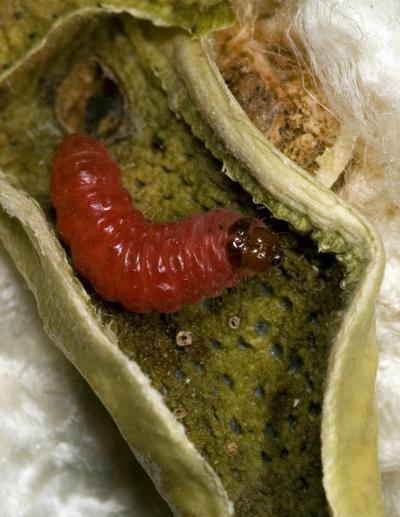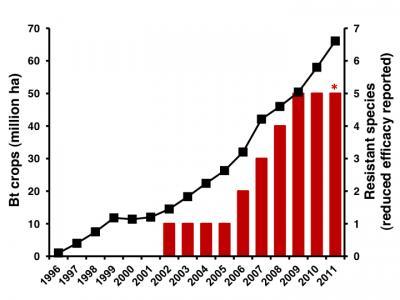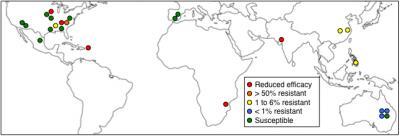Since 1996, farmers across the world have planted more than a billion acres of genetically modified corn and cotton that produce insecticidal proteins from the soil bacterium Bacillus thuringiensis, called Bt for short.
Bt proteins, used for decades in sprays by organic farmers, kill some devastating pests but are environmentally friendly and harmless to people. Some scientists have feared that widespread use of these proteins in genetically modified crops would spur rapid evolution of resistance in pests, while opponents predicted Armageddon due to such a biological arms race.
The science question is why pests in some areas became resistant quickly, while those in others did not. Bruce Tabashnik and Yves Carrière in the department of entomology at the University of Arizona, together with visiting scholar Thierry Brévault from the Center for Agricultural Research for Development (CIRAD) in Franc,e scrutinized the available field and laboratory data to test predictions about resistance.
"When Bt crops were first introduced, the main question was how quickly would pests adapt and evolve resistance," said Tabashnik, who led the study. "And no one really knew, we were just guessing. Now, with a billion acres of these crops planted over the past 16 years, and with the data accumulated over that period, we have a better scientific understanding of how fast the insects evolve resistance and why."
Analyzing data from 77 studies of 13 pest species in eight countries on five continents, the researchers found well-documented cases of field-evolved resistance to Bt crops in five major pests as of 2010, compared with only one such case in 2005. Three of the five cases are in the United States, where farmers have planted about half of the world's Bt crop acreage. Their report indicates that in the worst cases, resistance evolved in 2 to 3 years; but in the best cases, effectiveness of Bt crops has been sustained more than 15 years.

A pink bollworm caterpillar emerges after devouring the seeds within a cotton boll. This devastating pest quickly evolved resistance to genetically modified cotton in India, but not in the southwestern United States where a coordinated resistance management program has been in place since the biotech crop was introduced in 1996. Credit: Alex Yelich, The University of Arizona
According to the paper, both the best and worst outcomes correspond with predictions from evolutionary principles.
"The factors we found to favor sustained efficacy of Bt crops are in line with what we would expect based on evolutionary theory," said Carrière, explaining that conditions are most favorable if resistance genes are initially rare in pest populations; inheritance of resistance is recessive – meaning insects survive on Bt plants only if have two copies of a resistance gene, one from each parent – and abundant refuges are present. Refuges consist of standard, non-Bt plants that pests can eat without ingesting Bt toxins.
"Computer models showed that refuges should be especially good for delaying resistance when inheritance of resistance in the pest is recessive," explained Carrière.
Planting refuges near Bt crops reduces the chances that two resistant insects will mate with each other, making it more likely they will breed with a susceptible mate, yielding offspring that are killed by the Bt crop. The value of refuges has been controversial, and in recent years, the EPA has relaxed its requirements for planting refuges in the U.S.

By 2011, the area planted worldwide to genetically engineered Bt corn and Bt cotton increased to 66 million hectares (160 million acres) and the number of pest species with resistance causing reducing efficacy of Bt crops climbed to five. The asterisk indicates the number of resistant pests could be underestimated for 2011 because reports of field-evolved resistance typically are published two or more years after resistance is first detected. Credit: Image courtesy of Nature Biotechnology
"Perhaps the most compelling evidence that refuges work comes from the pink bollworm, which evolved resistance rapidly to Bt cotton in India, but not in the U.S.," Tabashnik said. "Same pest, same crop, same Bt protein, but very different outcomes."
He explained that in the southwestern U.S., scientists from the EPA, academia, industry and the USDA worked with growers to craft and implement an effective refuge strategy. In India, on the other hand, the refuge requirement was similar, but without the collaborative infrastructure, compliance was low.
One of the paper's main conclusions is that evaluating two factors can help to gauge the risk of resistance before Bt crops are commercialized. "If the data indicate that the pest's resistance is likely to be recessive and resistance is rare initially, the risk of rapid resistance evolution is low," Tabashnik said. In such cases, setting aside a relatively small area of land for refuges can delay resistance substantially. Conversely, failure to meet one or both of these criteria signifies a higher risk of resistance.
When higher risk is indicated, Tabashnik describes a fork in the road, with two paths: "Either take more stringent measures to delay resistance such as requiring larger refuges, or this pest will probably evolve resistance quickly to this Bt crop."

Global status of field-evolved pest resistance to Bt crops: Of the 24 cases analyzed, five showed resistance that caused reduced efficacy of Bt crops (red), five were intermediate levels of resistance (orange and yellow), and 14 showed either little or no resistance (blue and green). Image courtesy of Nature Biotechnology
Two leading experts on Bt crops welcomed publication of the study. Kongming Wu, director of the Institute for Plant Protection at the Chinese Academy of Agricultural Sciences in Beijing said, "This review paper will be very helpful for understanding insect resistance in agricultural systems and improving strategies to sustain the effectiveness of Bt crops." Fred Gould, professor of entomology at North Carolina State University, commented: "It's great to have an up-to-date, comprehensive review of what we know about resistance to transgenic insecticidal crops."
Although the new report is the most comprehensive evaluation of pest resistance to Bt crops so far, Tabashnik emphasized that it represents only the beginning of using systematic data analyses to enhance understanding and management of resistance.
"These plants have been remarkably useful and in most cases, resistance has evolved slower than expected," Tabashnik said. "I see these crops as an increasingly important part of the future of agriculture. The progress made provides motivation to collect more data and to incorporate it in planning future crop deployments. We've also started exchanging ideas and information with scientists facing related challenges, such as herbicide resistance in weeds and resistance to drugs in bacteria, HIV and cancer."
But will farmers ever be able to prevent resistance altogether? Tabashnik said he doesn't think so.
"You're always expecting the pest to adapt. It's almost a given that preventing the evolution of resistance is not possible."
Citation: Bruce E Tabashnik, Thierry Brévault and Yves Carrière, 'Insect resistance to Bt crops: lessons from the first billion acres', Nature Biotechnology 31, 510–521 (2013) doi:10.1038/nbt.2597





Comments